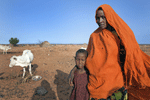Eastern Africa: Pastoralism in arid lands can help defeat hunger
Published on Wed, 2011-09-14 09:05
Source: Afronline As hunger threatens 12 million people in the Horn of Africa, a study by the International Livestock Research Institute (ILRI) of the response to Kenya’s last devastating drought found that investments to increase the mobility of livestock herders – a way of life often viewed as “backward” despite being the most economical and productive use of that country’s drylands – could be the key to avert future food crises. The report, “An assessment of the response to the 2008–2009 drought in Kenya,” suggests that herding makes better economic sense than crop agriculture in many of the arid and semi-arid lands that constitute 80 percent of the Horn of Africa. Supporting mobile livestock herding communities in advance and with timely interventions can help people to cope the next drought, it says. Encouraging livestock herders to switch to farm crops is unrealistic without extensive irrigation in areas where the water is very scarce, warns the study. Some 70 million people live in the arid lands of the Horn of Africa, and many of them are herders. The Intergovernmental Authority on Development in Eastern Africa (IGAD) estimates that pastoral herds represent over 90 percent of the meat consumed in the seven countries of the bloc (Djibouti, Eritrea, Ethiopia and Somalia, all of them in the Horn, plus Kenya, Sudan and Uganda). “Drylands in the Horn of Africa are too large to ignore,” said Jan de Leeuw, one of the authors of ILRI’s report. The region should take a look at the case of Kenya, “with only 20 percent of its land suitable for arable crop production and with an expanding population”. “The country cannot continue ignoring the dry areas. Some of the worst impacts of the drought on the food production can be avoided if the region’s dryland livestock systems are well regulated,” de Leeuw added, The best way to prevent famine in arid lands is to ensure herder access to critical dry-season grazing and watering areas. All the herders interviewed for the report said that obstacles to the movement of their cattle included: lack of roads, land conflicts and demographic pressures. Another problem cited was the lack of commercial livestock markets. Thus, during droughts, it is more helpful for local government agencies to organize the slaughter of the cattle surplus on site – paying herders for the fresh meat, and giving it to the local communities to eat – than it is to ship large amounts of fodder to drought-struck areas, or to try to transport cattle off these lands. The authors found that investments in roads, markets, information access, agricultural outreach and schemes that pay herders for wildlife conservation and other ecological services may cost money in the short run, but in the long-term will help stabilize dryland communities and prevent famines. The 2008-2009 drought was devastating. More than half of all livestock died in many districts. The loss of livestock assets in successive droughts has had the effect of steadily impoverishing many herders in Kenya and the Horn of Africa. Thus, the ILRI’s study, which was funded by the European Union, reinforces the idea that migratory herding is the most productive use of this land. “The best way to tap into the potential of the drylands is to invest in systems that support pastoral livelihoods, rather than ignoring them and hoping they go away,” said de Leeuw. “While such investments are risky, these areas provide most of the animal protein consumed by the residents of the Horn countries.” However, drylands and the pastoral livelihoods they support have long borne the brunt of underdevelopment, underinvestment and ineffective government policies that have encouraged mobile herders to transit into more settled ways of life. More information
» |
SUSCRIBE TO OUR NEWSLETTER



